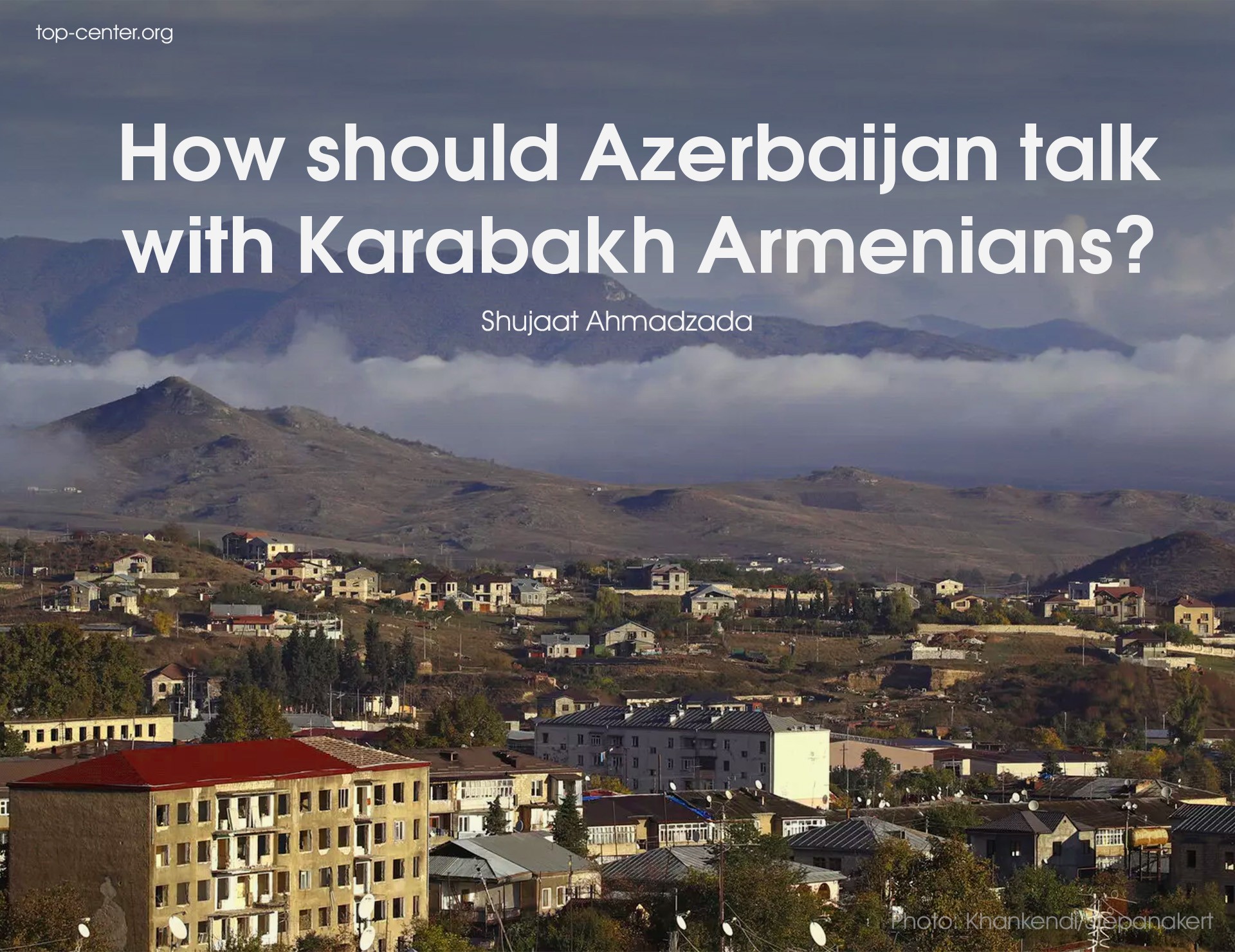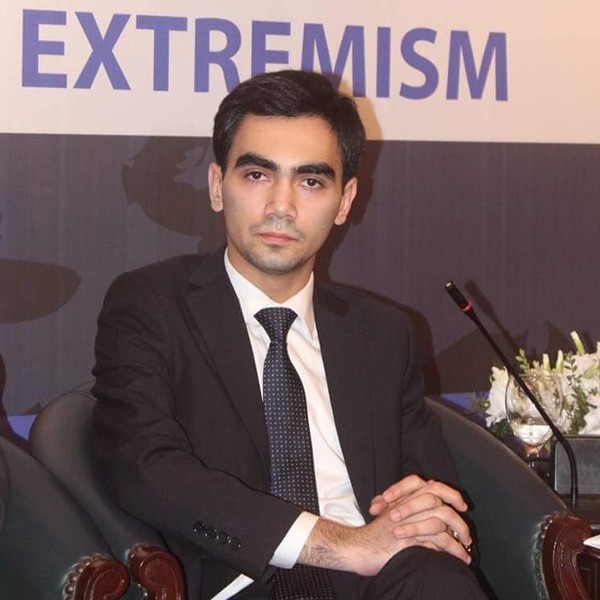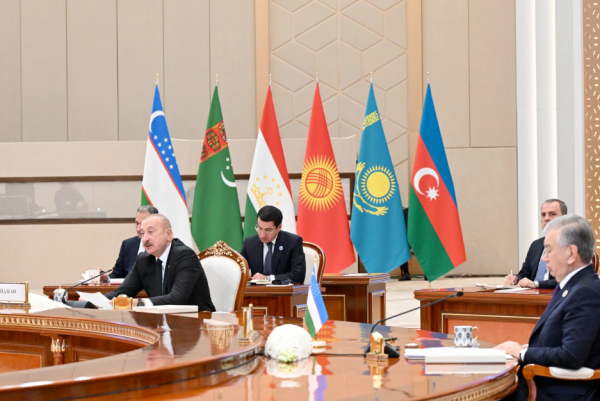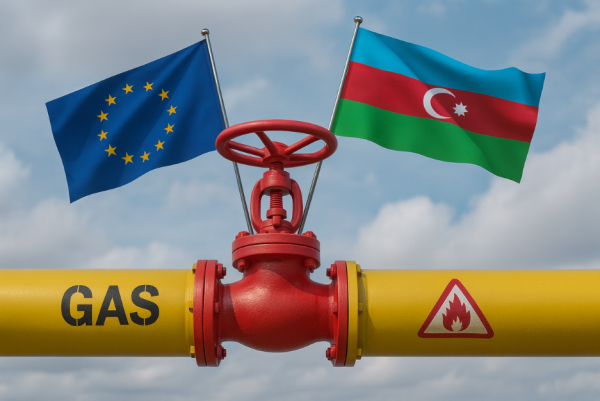How should Azerbaijan talk with Karabakh Armenians?

On October 30, tens of thousands of people gathered in the central square of Khankendi/Stepanakert. These protests, which supposedly attracted over 40,000 participants, were arranged in opposition to the handing over of Armenian-populated parts of Karabakh back to Azerbaijani sovereignty. Still under the control of an unrecognized secessionist regime is a sizable portion of Nagorno-Karabakh, which is recognized as part of Azerbaijan per international law.
Armenia and Azerbaijan have been in conflict over Nagorno-Karabakh for 34 years now. The conflict began when the Karabakh Armenians, who enjoyed ethno-territorial autonomy within Soviet Azerbaijan, started their struggle for unification with Soviet Armenia and has resulted in more than 30,000 fatalities and more than one million people being forced from their homes.
Following the dissolution of the Soviet Union, Armenia gained a decisive military victory during the First Karabakh War (1992–1994); not only was Nagorno-Karabakh occupied, but also seven surrounding administrative districts, each with ethnic Azerbaijanis as a majority. The OSCE Minsk Group troika - consisting of France, Russia, and the United States – worked on peace negotiations for 26 years, but all proved fruitless. In 2020 the second round of war commenced; Azerbaijan was able to regain most of its occupied territories, and Russia's peacekeeping contingent has been deployed to two-thirds of Nagorno-Karabakh and the Lachin corridor, which provides the region's connection with Armenia.
Both positively and negatively, the post-2020 period has been quite dynamic for Armenia and Azerbaijan. It was during this period that military clashes intensified along the undermarcated border between the two states. On September 13-14, 2022, a small border war took place in the true sense of the word. Positively, shuttle diplomacy by the European Union and the United States has led to the first-ever understanding between the two nations to sign a peace treaty by the end of this year in order to put an end to the decades-old conflict.
Today, Armenia and Azerbaijan have conflicting positions over five issues. The first is the future and legal foundations of relations between the two states. The second is the future of borders between the two states. The future of transport and communication lines is the third package. The fourth package includes humanitarian problems (POWs, landmines, missing persons). The political status of Armenians residing in Karabakh is the fifth and most fiercely debated subject.
“This conflict started with the status and will end with the status,” stated an Armenian diplomat years ago. The Armenians of Karabakh, dissatisfied with their ethnopolitical status within Soviet Azerbaijan, lived for many years outside Baku's control, actually within Armenia, as a result of the victory they achieved with Armenia's support in 1994. Except few symbolic distinctions between Armenia and Nagorno-Karabakh, a single polity - augmented Armenia - encompassed territories from Shirak to Fuzuli.
For 26 years, international mediators had made various efforts to find a compromise option for Armenia and Azerbaijan. In a nutshell, most proposals for a just settlement called for the return to Azerbaijan of the Armenian-occupied areas around Nagorno-Karabakh, for a high degree of territorial autonomy for Nagorno-Karabakh within Azerbaijan, and for international security guarantees. However, the proposed 'liberal conflict settlement model' did not work as a result of the parties' preference for 'illiberal resolution methods' (war, prolonging the occupation).
The conflict over Karabakh has officially ended, according to Azerbaijan. Baku says that no outside player is welcome to discuss the future of the Armenians of Karabakh. The current stance of Baku, which previously agreed to see Nagorno-Karabakh as an autonomous entity inside Azerbaijan, can be seen as a maximalist approach to diplomatic gambling. Thus, like Armenia had been doing for 26 years, Baku is attempting to keep its preponderance at the bargaining table to gain the most advantageous outcome.
It is the existence of two national concepts built on denial that prevents Armenia and Azerbaijan from agreeing on the status of Karabakh Armenians. The Azerbaijani national concept completely excludes Karabakh Armenians from the very understanding of "Azerbaijani", whereas the Armenian national concept denies the existence of Azerbaijanis from Karabakh.
In a situation with such conflicting national concepts, conflict resolution theories urge the establishment of ethno-territorial autonomies as the best course of action. Today, it seems improbable that Azerbaijan would consent to the establishment of any autonomy within its borders. Having won the war, Baku views efforts to establish autonomy as a threat to its sovereignty and territorial integrity. Perhaps, many nation-states would demonstrate a Machiavellian stance against the secessionist inclinations of ethnic minorities; Armenia would have reacted similarly to the autonomy demand of its Azerbaijani minority if Azerbaijanis were not uprooted from their homes.
Because of the real Gordian Knot predicament over Karabakh, I advocated for following Israel and Palestine's 1993 course in my paper from August 2022. That is, until the final political status is found, the restoration of Azerbaijani sovereignty over the parts of Karabakh inhabited by Azerbaijanis, the protection of the status quo in the territories inhabited by Armenians, the institutionalization of contacts between Karabakh Armenians and Baku, and the provision of security by a third party (ies). My objective in writing this paper is to offer some of my thoughts on how to establish contact between Armenians residing in Karabakh and the authorities in Baku.
Sooner or later, Azerbaijan should sit at the table with the Karabakh Armenians, whom it considers its citizens. Speaking to your citizens is not a sign of shame but rather an advantage, even though this action may be viewed by many Azerbaijanis as inappropriate and a stain on the nation's “honor”. By speaking with the individuals responsible for the terrorist attacks (IRA) in London, the United Kingdom was able to bring about peace in Northern Ireland. Moscow was able to protect Russia's territorial integrity by negotiating with Chechens. Ankara put an end to the ringlet of terrorism that had killed hundreds of innocent citizens in southeast Anatolia by negotiating with PKK. Neither Azerbaijan nor Karabakh Armenians are exceptions in this regard.
To start discussions with Karabakh Armenians, the government of Azerbaijan can appoint a special representative on reintegration issues. A joint statement can even be signed between the government of Azerbaijan and the Armenians of Karabakh. This would not be something unheard of or unprecedented, because, in August 1919, Karabakh Armenians signed a declaration with the representatives of the First Azerbaijani Republic; they were given cultural autonomy in exchange for accepting to be part of Azerbaijan.
It is vital to involve cultural and public figures in this process at the beginning because it would be ludicrous to expect the Azerbaijani government to negotiate with those who oversaw military operations against the ethnic Azerbaijani population during the First Karabakh War. The legitimacy of the Karabakh Armenian community leaders should, however, be addressed at some point in the process. The Azerbaijani authorities can state that they would accept the outcomes of the municipal elections held in villages and towns. Although it is inconceivable to see the "parliamentary" and "presidential" elections held in the separatist enclave getting recognized, accepting the village representatives as legitimate individuals in itself cannot undermine the territorial integrity and the sovereignty of Azerbaijan.
The fate of the displaced Armenians is another crucial issue that needs to be settled. It is now known that approximately 20–25 thousand Armenians, who had resided within the ex-NKAO boundaries, were uprooted from their houses. In this context, the Azerbaijani government should establish conditions for the return of the displaced Armenians from the former settlements of the ex-NKAO, particularly the ones from Hadrut. Baku, in collaboration with the European Union and the UNHCR, might develop new mechanisms to guarantee this return. If the Russian peacekeeping forces leave the region, this mechanism can be used to institutionalize ties between Baku and the Armenian community of Karabakh.
One of the biggest protests in Baku is the existence of armed groups (known as the Nagorno-Karabakh Defence Army) organized by the Armenian residents of Karabakh. The self-defense forces give the Armenian population a sense of security even if it is no match to the Armed Forces of Azerbaijan. The assistance and expertise of international actors (EU, UN) can be used in the abolition of this para-military force. Instead, new local police and gendarmerie units can be formed to guard Karabakh's Armenian settlements. The Azerbaijani side can declare an amnesty for those who are on its wanted list and undertake that the Armenian soldiers who took part in the war will not be brought before the court.
The next action Azerbaijan can take regarding Karabakh Armenians is to alter its passport regulations. Armenians residing in Karabakh may be granted 'neutral' passports by the government of Azerbaijan. Georgia has already made advantage of this expertise to grant residents of Abkhazia and South Ossetia passports devoid of Georgian governmental emblems. The state symbols of Azerbaijan may not be present on these passports, and they may even utilize Armenian in the entry section.
The fact that Azerbaijan controls cultural and religious sites, particularly cemeteries, is another point of dissatisfaction for the Karabakh Armenians. To address this issue, the Armenian Apostolic Church may establish a diocese in Azerbaijan, and all Armenian churches and cemeteries located within the country may be placed under its administration. To foster more trust between parties, Ghazanchetsots (Shusha), Kanach Zham (Shusha), and Dadivank (Kalbajar) may be returned to the Armenian Apostolic Church.
Of course, the arms must be laid down for any of this to occur. One does not hold its population at gunpoint during negotiations. Even in the event that the peacekeepers depart, Azerbaijan should take it on faith that it won't use force against the Karabakh Armenians. The development of trust between the Azerbaijani and Armenian communities of Karabakh may benefit from a temporary moratorium on the entry of armed forces of Azerbaijan to the Armenian-inhabited parts of Karabakh.
From a broader perspective, the decentralization and more self-governance of Azerbaijan should go hand in hand with the process of reintegrating Armenians from Karabakh. Azerbaijan can only prosper through reforming its outdated administrative-territorial system, which is a holdover from the Soviet era and does not meet any modern standards whatsoever. Other changes include enhancing the role of municipalities and strengthening the authority of local authorities. Restoring inter-communal ties and confidence is the key to the revival of Karabakh, which international law recognizes as Azerbaijan's inalienable part.







